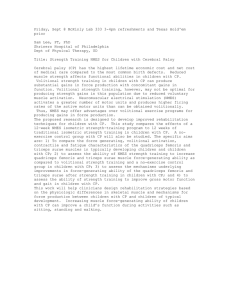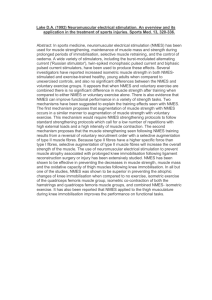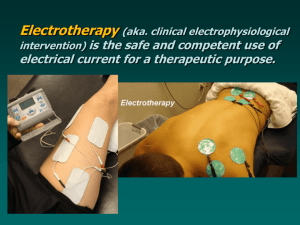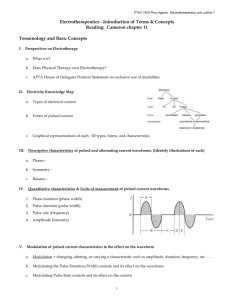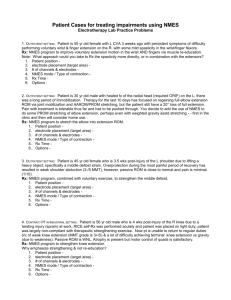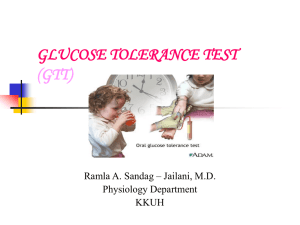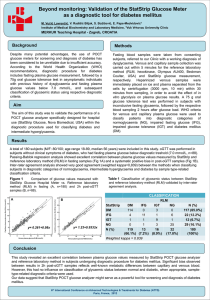Giggins et al, RTRS, 2010
advertisement
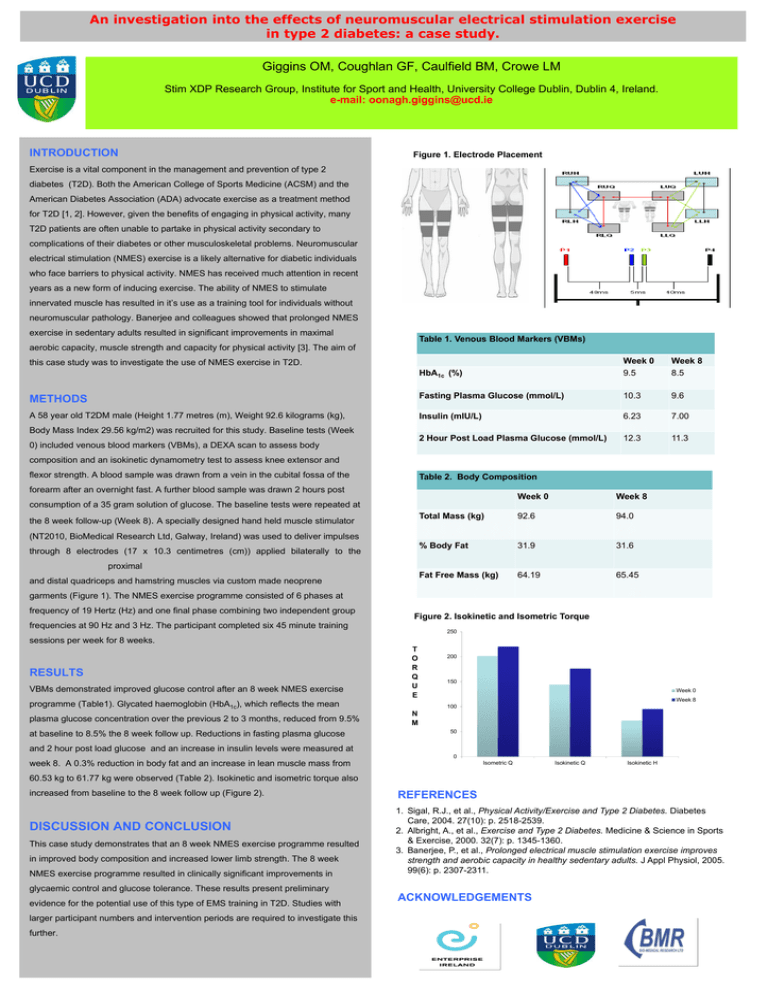
An investigation into the effects of neuromuscular electrical stimulation exercise in type 2 diabetes: a case study. Giggins OM, Coughlan GF, Caulfield BM, Crowe LM Stim XDP Research Group, Institute for Sport and Health, University College Dublin, Dublin 4, Ireland. e-mail: oonagh.giggins@ucd.ie INTRODUCTION Figure 1. Electrode Placement Exercise is a vital component in the management and prevention of type 2 diabetes (T2D). Both the American College of Sports Medicine (ACSM) and the American Diabetes Association (ADA) advocate exercise as a treatment method for T2D [1, 2]. However, given the benefits of engaging in physical activity, many T2D patients are often unable to partake in physical activity secondary to complications of their diabetes or other musculoskeletal problems. Neuromuscular electrical stimulation (NMES) exercise is a likely alternative for diabetic individuals who face barriers to physical activity. NMES has received much attention in recent years as a new form of inducing exercise. The ability of NMES to stimulate innervated muscle has resulted in it’s use as a training tool for individuals without neuromuscular pathology. Banerjee and colleagues showed that prolonged NMES exercise in sedentary adults resulted in significant improvements in maximal Table 1. Venous Blood Markers (VBMs) aerobic capacity, muscle strength and capacity for physical activity [3]. The aim of HbA1c (%) Week 0 9.5 Week 8 8.5 METHODS Fasting Plasma Glucose (mmol/L) 10.3 9.6 A 58 year old T2DM male (Height 1.77 metres (m), Weight 92.6 kilograms (kg), Insulin (mIU/L) 6.23 7.00 2 Hour Post Load Plasma Glucose (mmol/L) 12.3 11.3 this case study was to investigate the use of NMES exercise in T2D. Body Mass Index 29.56 kg/m2) was recruited for this study. Baseline tests (Week 0) included venous blood markers (VBMs), a DEXA scan to assess body composition and an isokinetic dynamometry test to assess knee extensor and flexor strength. A blood sample was drawn from a vein in the cubital fossa of the Table 2. Body Composition forearm after an overnight fast. A further blood sample was drawn 2 hours post Week 0 Week 8 Total Mass (kg) 92.6 94.0 % Body Fat 31.9 31.6 Fat Free Mass (kg) 64.19 65.45 consumption of a 35 gram solution of glucose. The baseline tests were repeated at the 8 week follow-up (Week 8). A specially designed hand held muscle stimulator (NT2010, BioMedical Research Ltd, Galway, Ireland) was used to deliver impulses through 8 electrodes (17 x 10.3 centimetres (cm)) applied bilaterally to the proximal and distal quadriceps and hamstring muscles via custom made neoprene garments (Figure 1). The NMES exercise programme consisted of 6 phases at frequency of 19 Hertz (Hz) and one final phase combining two independent group Figure 2. Isokinetic and Isometric Torque frequencies at 90 Hz and 3 Hz. The participant completed six 45 minute training 250 sessions per week for 8 weeks. RESULTS VBMs demonstrated improved glucose control after an 8 week NMES exercise T O R Q U E programme (Table1). Glycated haemoglobin (HbA1c), which reflects the mean plasma glucose concentration over the previous 2 to 3 months, reduced from 9.5% at baseline to 8.5% the 8 week follow up. Reductions in fasting plasma glucose 200 150 Week 0 Week 8 100 N M 50 and 2 hour post load glucose and an increase in insulin levels were measured at 0 week 8. A 0.3% reduction in body fat and an increase in lean muscle mass from Isometric Q Isokinetic Q Isokinetic H 60.53 kg to 61.77 kg were observed (Table 2). Isokinetic and isometric torque also increased from baseline to the 8 week follow up (Figure 2). DISCUSSION AND CONCLUSION This case study demonstrates that an 8 week NMES exercise programme resulted in improved body composition and increased lower limb strength. The 8 week NMES exercise programme resulted in clinically significant improvements in REFERENCES 1. Sigal, R.J., et al., Physical Activity/Exercise and Type 2 Diabetes. Diabetes Care, 2004. 27(10): p. 2518-2539. 2. Albright, A., et al., Exercise and Type 2 Diabetes. Medicine & Science in Sports & Exercise, 2000. 32(7): p. 1345-1360. 3. Banerjee, P., et al., Prolonged electrical muscle stimulation exercise improves strength and aerobic capacity in healthy sedentary adults. J Appl Physiol, 2005. 99(6): p. 2307-2311. glycaemic control and glucose tolerance. These results present preliminary evidence for the potential use of this type of EMS training in T2D. Studies with larger participant numbers and intervention periods are required to investigate this further. ACKNOWLEDGEMENTS
